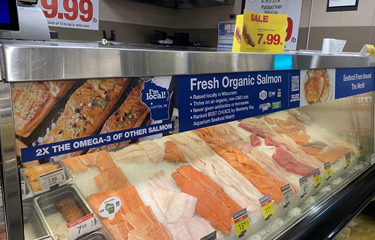Salmon remains top seller in US, despite inflation

Salmon remains one of the top-selling seafood items in U.S. grocery stores despite rising prices in recent months.
Salmon sales jumped 9.3 percent to more than USD 2.5 billion (EUR 2.5 billion) during the month. The category saw a significant sales hike despite the price per pound jumping 18.2 percent to USD 11.35 (EUR 11.06) for the four weeks ending 26 June. The growth in sales came despite inflation impacting overall fresh seafood sales, which dropped 6.2 percent to nearly USD 6.7 billion (EUR 6.5 billion) for the four weeks ending 10 July, according to IRI and 210 Analytics.
Salmon was the top-selling seafood species in U.S. supermarkets in the second quarter of 2022, with sales up 9.1 percent, according to IRI/210 Analytics. Crab sales dropped 34.2 percent in dollar terms but remained still the second-biggest seller by value in the second quarter, followed by shrimp, lobster, cod, and catfish.
Salmon volume fell 7.2 percent in the second quarter, but still accounted for 60 million pounds worth of volume in U.S. grocery stores.
“While fresh seafood is under severe pressure, salmon remains an absolute powerhouse. [The] salmon [market] is more than twice the size of the next-largest species in both dollars and volume,” 210 Analytics Principal Anne-Marie Roerink told SeafoodSource.
U.S. customers took advantage of the declining price of farmed salmon, which is coming off its record high set earlier this year, and grocers have been working to create excitement about seasonal, wild sockeye salmon from Copper River, Prince William Sound, and Bristol Bay.
“This means salmon can still move the needle on a planned or unplanned purchases,” Roerink said. “Grocery stores are looking for something different that catches their shoppers’ eyes. That’s what the return of wild salmon season does. It gives the seafood department some great social media tidbits, [and] in-store, it allows associates to engage with shoppers. It’s that kind of energy that tends to be contagious.”
In early July, Bristol Bay Sockeye Salmon, the consumer-facing brand managed by the Bristol Bay Regional Seafood Development Association, teamed up with major retailers including Whole Foods, Publix, and Quality Food Centers, to market sockeye from Bristol Bay in more than 3,200 stores across the U.S. And Matthews, North Carolina-based Harris Teeter is partnering with the Alaska Seafood Marketing Institute to promote Bristol Bay salmon in more than 120 grocery store demonstrations in their Southeast U.S. stores.
“This promotion features in-store chefs preparing sample recipes for customers, as well as branded aprons and point-of-sale collateral,” Bristol Bay Regional Seafood Development Association Marketing Director Lilani Dunn told SeafoodSource.
At the beginning of the wild salmon season, customers “really balked at the price,” QFC Meat and Seafood Merchandiser Adam Branin told SeafoodSource.
“It was the first time we really saw that happen,” Branin said “In years past, that opener created so much excitement, it didn’t seem to matter the price; our customers were buying it up.”
As a result, QFC temporarily halted orders until costs came down USD 10.00 (EUR 9.75) or more per pound. Once it achieved that price, it began its promotions in earnest, and sales skyrocketed, according to Branin. The retailer featured sockeye for USD 12.99 (EUR 12.66) a pound for one week on the front page of its circular, followed by another week at USD 10.99 (EUR 10.71) per pound on the front page.
“Thankfully, the cost did come off and we were able to drive retail [prices] down to much more-reasonable levels,” Branin said. “We sold more salmon in those two weeks than we ever have sold in that timeframe.”
Roerink said she has noticed numerous effective merchandising and marketing techniques on both wild and farmed salmon at major U.S. retailers this summer. Some promoted salmon pieces for grilling and easy meals to-go, while others touted salmon’s health benefits. One grocery chain featured orange marinated salmon on cedar planks, and marinated Korean BBQ salmon skewers, she said. Touting the health benefits of eating salmon, Wegmans displayed large signage over its packaged Atlantic salmon fillets stating, “Salmon contains heart-healthy omega-3s”. Wegmans also noted that its salmon supplier, Cermaq Farms, ships its salmon whole “to ensure peak freshness.”
“In my 20-plus store visits in the month of June alone, it really struck me how much retailers are doing surrounding wild-caught, sustainably-caught, and providing lots of education to consumers about the where, when, and who behind the seafood offering,” Roerink said. “While inflationary pressure is real, shoppers care about health and sustainability.”
Photo courtesy of 210 Analytics






Share